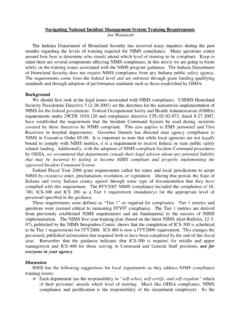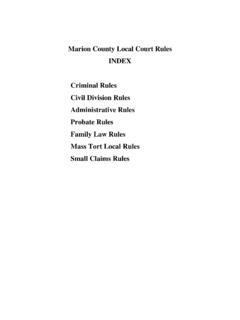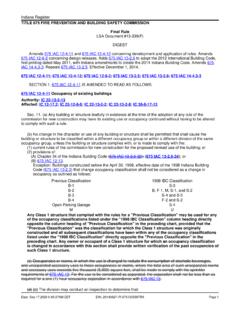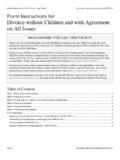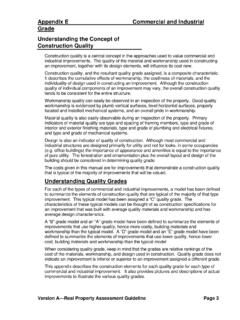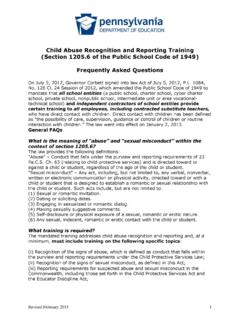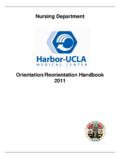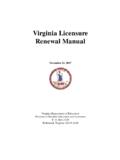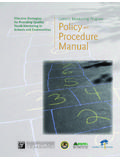Transcription of Evaluation of the Indiana Department of Child Services
1 Evaluation of the Indiana Department of Child Services The Child Welfare Policy and Practice Group June 18, 2018 2 Acknowledgements The Child Welfare Policy and Practice Group wishes to thank the 592 DCS internal and external respondents for their contributions to this Evaluation . Their constructive and candid feedback permitted evaluators to deepen their understanding of system functioning and Child and family outcomes. Additionally, reviewers wish to acknowledge the direct assistance of the many staff within DCS who went out of their way to respond to requests for documents and data and, in some instances to review these with members of the CWG team to ensure their correct interpretation. Particular recognition is deserved by David Clark and Nicole Ford in the DCS central office who were consistently and tirelessly available to assist reviewers, often during times that extended well beyond regular work hours.
2 CWG Evaluators Freida Baker, MSW Margaret Bonham, MSW, LCSW Sue Steib, PhD, LCSW George Taylor, MA Paul Vincent, MSW, LCSW 3 Executive Summary Purpose and Context of the Assessment This assessment of the Indiana Department of Child Services (DCS) was undertaken by the Child Welfare Policy and Practice Group (CWG) at the request of Governor Eric Holcomb, who asked CWG to: Examine the current performance of the Child welfare functions of the agency and compare it to generally accepted national practice standards and outcome measures Identify prominent strengths and challenges Produce recommendations for changes in any areas needing improvement Assessment activities began in January 2018 around the same time Terry Stigdon, the current Director of DCS, assumed her role. DCS had been dealing with rising numbers of Child abuse and neglect referrals for several years and an increasing number of children entering out-of-home care.
3 According to federal AFCARS data (Adoption and Foster Care Analysis and reporting System): In September 2005, DCS reported 10,767 children in out-of-home care. As of September 2017, DCS reported 20,394 children in out-of-home care, an additional 9,627 children or an percent increase. These data indicate the number of children in out-of-home care increased somewhat during the period from 2005 to 2010 and remained fairly stable in 2011 and 2012, before starting a much more dramatic upward trend in 2014. As of 2017, Indiana s rate of children in out-of-home care was about 13 children for every 1,000 in the state and is over twice the national average. During the same 12-year period as above, three neighboring states experienced decreases in the number of children in out-of-home care (per AFCARS): Illinois = percent decrease Kentucky = percent increase Michigan = percent decrease Ohio = percent decrease The increase of children in out-of-home care was seen as reflecting the epidemic of opioid addiction which has become a nationwide issue, but with greater acuity in Indiana than in some other states.
4 In addition to Indiana having a higher number of children in out-of-home care, Indiana also has a higher-than-average number of children being referred to Child protection. In 2016, Indiana s rate of referral to Child protection, calculated as the number of referrals for every 1,000 children in the state s population, was compared to a national average of Only Washington, , Vermont and West Virginia had higher rates of referrals. Of the referrals it received, Indiana screens in a somewhat higher-than-average number and completes a 4 substantially greater number of assessments or investigations on those referrals than do most states. Indiana s screen-in rate in 2016 was 66 percent compared to 58 percent nationally Indiana completed Child abuse and neglect assessments for every 1,000 children in the state s population in 2016.
5 This was the third highest rate in the nation, exceeded only by Washington, at and West Virginia at The rate of reports assessed in Indiana grew by almost 63 percent from state fiscal year 2013 to state fiscal year 2017. Also important to note is that in five years, external evaluators have prepared five Evaluation reports about DCS, requiring much time on behalf of evaluators and DCS staff and leadership. A large number of these recommendations have not yet been implemented. Methodology CWG s assessment activities focused on state level operations in Indianapolis and also on five regions of the state. The regions were selected based on size and geographic location, as well as demographic factors such as the incidence of poverty and substance abuse , both associated with a greater need for Child welfare Services .
6 The following five counties and their corresponding DCS regions were selected: Allen, Clark, Lake, Marion and Vanderburgh. Members of the CWG team reviewed internal documents including DCS policy, reports of quantitative data indicators, and quality assurance reports. CWG conducted interviews with representatives of DCS staff at all levels, as well as with key individuals in state partner agencies, service provider organizations, the courts and legal system, service recipients, foster and adoptive parents and other external stakeholders such as representatives of advocacy organizations. A total of 592 individuals were interviewed in 283 sessions. CWG reviewers spent at least the hour equivalent of a full work day shadowing DCS family case managers (FCM) in the central intake unit and in county offices of the five sampled regions.
7 They also examined indicators of organizational capacity such as budgets, service contracts and data describing the Child welfare workforce and workloads. Lastly, they conducted a review of a small sample of case record documents representing Child protection assessments and ongoing Services to families and children. Findings Analysis of data collected in the assessment revealed a number of notable strengths and challenges in DCS. Strengths There is a high level of interest in and support of DCS at both the executive and legislative levels. The State Budget Agency has assisted DCS financially in the past several years by substantially augmenting the DCS general fund appropriation. 5 Director Stigdon has been regularly interacting with front-line staff, partner agencies, and others to learn more about the system and solicit feedback about system strengths and challenges.
8 Director Stigdon also has a strong interest in expanding the agency s investment in evidence-based prevention efforts. DCS staff are consistent advocates for children and families throughout the state. Almost half of the children who are in out-of-home care in Indiana are placed with relatives, which is associated with lessening Child trauma and increasing placement stability. Nationally, Indiana is among the states with the greatest percent of children in kinship settings. DCS has a defined practice model that aligns with prevailing standards of family-centered practice. DCS has strong relationships with partner agencies and service providers at the state level and in many counties and communities. DCS has an overall collaborative and cooperative relationship with the courts. DCS policy is available online and accessible both internally and externally.
9 DCS offers specialty teams ( , clinicians, educational consultants, medical consultants) to support case managers and supervisors. The state has a relatively large number of private-sector service providers who want a closer partnership with DCS. DCS makes ongoing use of Casey Family Program s Permanency Roundtable model for children and youth remaining in out-of-home care without reaching permanency goals. DCS has a well-structured training section and partnership with Indiana University s School of Social Work. The DCS draft federal Program Improvement Plan contains many strategies that are responsive to challenges the system faces. The state supports legal representation of all parties in Child in Need of Services (CHINS) court proceedings. DCS is in the process of hiring the 16 new attorney positions created this year to help address high workloads.
10 Overall, permanency outcomes for children in out-of-home care in Indiana meet or approach national standards. Regular stakeholder meetings within each of the regions have been described as helpful in ensuring awareness of policies and external information, and promoting partnership. Challenges Indiana has a very high rate of children in out-of-home care relative to surrounding states and nationally. DCS has a high rate of Child abuse and neglect referrals and broad mandates for Child welfare involvement relative to surrounding states and nationally. Indiana has an exceptionally high rate of court involvement in Child welfare cases. While this adds oversight to Child welfare cases, it also results in higher staff caseloads, more staff time in court and higher DCS costs. 6 The DCS data system does not allow for staff at all levels to easily assess performance in relation to key safety, permanency and well-being outcomes for children and families served by DCS.
